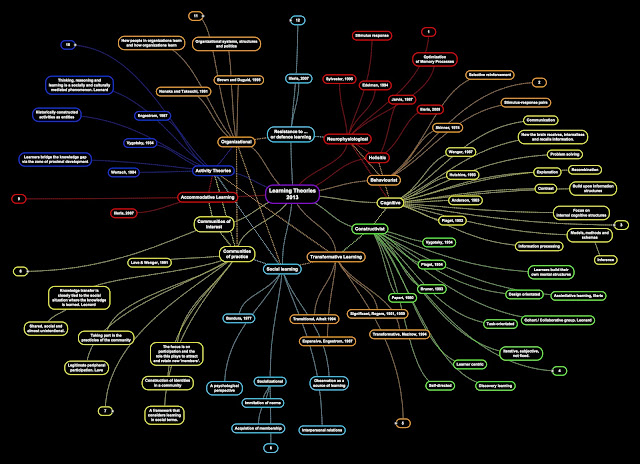Had this been the title of a post-graduate diploma in e–learning it would have been precisely what I was looking for a decade ago – the application of theory, based on research and case studies, to the design and production of interactive learning – whether DVD or online.
A few excellent, practical guides did this, but as a statement of fact, like a recipe in a cook book: do this and it’ll work, rather than suggesting actions based on research, evidence-based understanding and case studies.
Mayes and de Frietas (2004) are featured in detail in Appendix 1 of Rethinking Pedagogy for a Digital Age (2007) Beetham and Sharpe.
Four types of learning are featured:
- 1. associative
- 2. constructive (individual)
- 3. constructive (social)
- 4. and situative.
Of these I see associative used in corporate training online – with some constructive (individual), while constructive (social) is surely the OU's approach?
Situative learning may be the most powerful – through application in a collaborative, working environment I can see that this is perhaps describes what goes on in any case, with the wiser and experienced passing on knowledge and know how to juniors, formally as trainees or apprentices, or informally by 'being there' and taking part.
Each if these approaches have their champions:
Associative – Skinner, Gagné (1985).
Constructive (individual) – Piaget (1970), Papert (1993), Kolb (1984), Biggs (1999).
Constructive (social) – Vygotsky (1978).
Situative – Wenger (1998), Cole (1993), Wertsch. (Also Cox, Seely Brown). Wertsch (1981), Engestrom (), Cole and Engeström (1993)
Beetham and Sharpe (2007:L5987) – the ‘L’ refers to the location in a Kindle Edition. I can’t figure out how to translate this into a page reference.
How people learn and the implications for design
Associative – Skinner, Gagné (1985) (in Mayes and de Frietas, 2004)
Building concepts or competences step by step.
The Theory
People learn by association through:
- basic stimulus–response conditioning,
- later association concepts in a chain of reasoning,
- or associating steps in a chain of activity to build a composite skill.
Associativity leads to accuracy of reproduction. (Mnemonics are associative devices).
- Routines of organized activity.
- Progression through component concepts or skills.
- Clear goals and feedback.
- Individualized pathways matched to performance.
- Analysis into component units.
- Progressive sequences of component–to–composite skills or concepts.
- Clear instructional approach for each unit.
- Highly focused objectives.
For Assessment
- Accurate reproduction of knowledge.
- Component performance.
- Clear criteria: rapid, reliable feedback.
- Guided instruction.
- Drill and practice.
- Instructional design.
- Socratic dialogue.
FURTHER READING (and viewing)
Brown, J.S. (2002) The Social Life of Information
Brown, J.S. (2007) October 2007 webcast: http://stadium.open.ac.uk/stadia/preview.php?whichevent=1063&s=31
+My notes on this:
http://learn1.open.ac.uk/mod/oublog/viewpost.php?u=jv276&time=1298439366&post=0
+The transcript of that session:
http://learn.open.ac.uk/file.php/7325/block1/H800_B1_Week2a_JSBrown_Transcript.rtf
REFERENCE
Biggs, J (1999) Teaching for Quality Learning at University, Buckingham: The Society for Research in Higher Education and Open University Press. (Constructive alignment)
Cole, M. and Engestrom, Y. (1993) ‘A cultural-historical approach to distributed cognition’, in G. Salomon (ed.) Distributed Cognitions: Psychological and Educational Considerations, New Work: Cambridge University Press.
Conole, G. (2004) Report on the Effectiveness of Tools for e-Learning, Bristol: JISC (Research Study on the Effectiveness of Resources, Tools and Support Services used by Practitioners in Designing and Delivering E-Learning Activities)
Cox, R. (2006) Vicarious Learning and Case-based Teaching of Clinical Reasoning Skills (2004–2006) [online], http://www.esrcsocietytoday.ac.uk/ esrcinfocentre/ viewawardpage.aspx?awardnumber=RES-139-25-0127 [(last accessed 10 March 2011).
Engeström, Y (1999) ‘Activity theory and individual and social transformation’, in Y. Engeström, R, Miettinen and R.-L. Punamaki (eds) Perspectives on Activity Theory, Cambridge: Cambridge University Press.
Eraut, M (2000) ‘Non-formal learning and tacit knowledge in professional work’, British Journal of Educational Psychology, 70:113-36
Gagné, R. (1985) The Conditions of Learning, New York: Holt, Rinehart & Winston.
Gagné, R.M., Briggs, L.J. and Wagner, W.W. (1992) Principles of Instructional Design, New Work: Hoplt, Reihhart & Winston Inc.
Kolb, D.A. (1984) Experiential Learning: Experience as a Source of Learning and Development, (Kolb’s Learning Cycle) Englewoods Cliffs, NJ: Prentice-Hall
Kolb, D.A. (1984) Experiential Learning: Experience as the Source of Learning and Development, Englewood Cliffs, N.J: Prentice Hall.
Littlejohn, A. and McGill, L. (2004) Effective Resources for E-learning, Bristol: JISC (Research Study on the Effectiveness of Resources, Tools and Support Services used by Practitioners in Designing and Delivering E-learning Activities).
Mayes, T. and de Frietas, S. (2004) 'Review of e–learning theories, frameworks and models. Stage 2 of the e–learning models disk study', Bristol. JISC. Online.
Piaget, J. (1970) Science of Education and the Psychology of the Child (Constructivist Theory of Knowledge), New Work: Orion Press.
Papert, S. (1993) Mindstorms: Children, Computers and Powerful Ideas, New Work: Perseus.
Piaget, J. (2001) The Language and Thought of the Child, London: Routledge Modern Classics.
Seely-Brown, J.S and Duguid, P. (1991) ‘Organizational learning and communities-of-practice: toward a unified view of working, learning and innovation’, Organizational Science, 2 (1): 40-57
Schon, D (1983) The Reflective Practioner: How Professional Think in Action, New York: Basic Books.
Sharpe, R (2004) ‘How do professionals learn and develop? In D.Baume and P.Kahn (eds) Enhancing Staff and Educational Development, London: Routledge-Flamer, pp. 132-53.
Vygotsky, L.S. (1978) Mind in Society, Cambridge, MA: Harvard University Press.
Vygotsky, L.S. (1986) Thought and Languages, Cambridge, MA: MIT Press.
Wenger, E. (1998) Communities of Practice: Learning, Meaning, and Identity, Cambridge: Cambridge University Press.
Wertsch, J.V. (1981) (ed.) The Concept of Activity in Soviet Psychology, Armonk, N
Appendix and references largely from Beetham, H, and Sharpe, R (2007) Rethinking Pedagogy in a digital age.
See also Appendix 4: Learning activity design: a checklist
